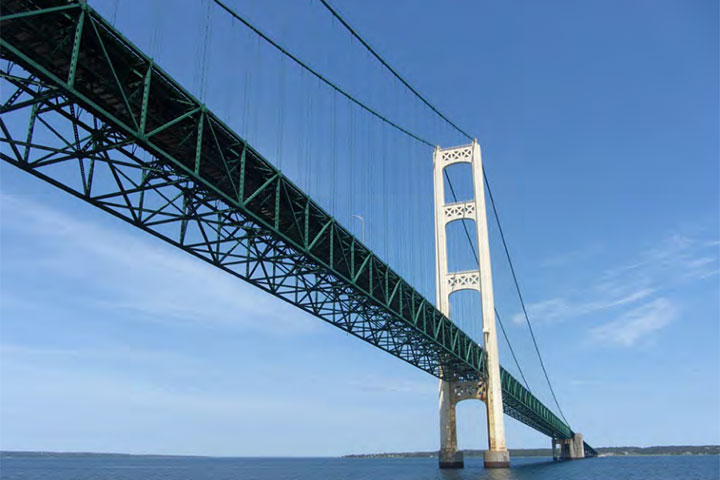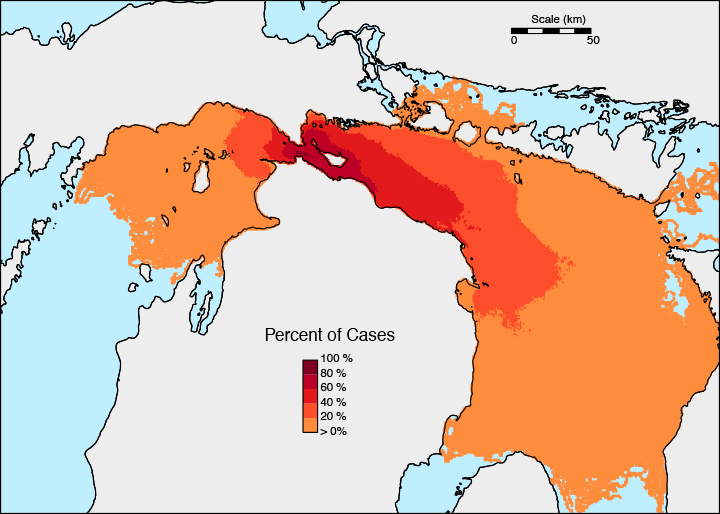
University of Michigan Water Center researcher Dave Schwab illustrated the potential danger of a possible oil spill near the Straits of Mackinac using computer modeling to show how the oil quickly spreads to Lake Huron, and Lake Michigan, contaminating shoreline areas miles away from the Line 5 pipeline (watch animation series on YouTube).
Compelling Results
In the most comprehensive study of Line 5 oil spill impacts publicly available, Schwab presents three potential levels of oil discharge — measured in barrels (bbl), each containing 42 US gallons of oil — including 5,000 bbl, 10,000 bbl and 25,000 bbl in a report released in 2016. Schwab simulated 840 hypothetical spill cases. The methods used in this model are equivalent to those used in the operational NOAA oil spill model and an earlier pilot study from 2014. For results from the 2016 full report and the 2014 pilot study, see Learn More below.
Highest Risk
 Probability (percent of cases) in which oil is present at any time after initial release. Enlarge | Download PDF
Probability (percent of cases) in which oil is present at any time after initial release. Enlarge | Download PDF A total of 720 miles of shoreline is considered potentially vulnerable to Straits of Mackinac oil spills. This map shows the probability that beached oil concentrations would exceed the threshold needed to trigger shoreline cleanup following the release of 25,000 barrels at the Straits of Mackinac. Enlarge | Download PDF
A total of 720 miles of shoreline is considered potentially vulnerable to Straits of Mackinac oil spills. This map shows the probability that beached oil concentrations would exceed the threshold needed to trigger shoreline cleanup following the release of 25,000 barrels at the Straits of Mackinac. Enlarge | Download PDFAreas at highest risk include Mackinac and Bois Blanc Islands, Mackinaw City, the shorelines east and west of the city and areas on the north shore of the Straits near the Mackinac Bridge. Communities at risk also include Beaver Island, Cross Village, Harbor Springs, Cheboygan and other areas of the Lake Huron-Michigan shoreline.
Key Findings
- More than 700 miles of shoreline in Lakes Michigan and Huron and on their islands are potentially vulnerable to an oil release in the Straits that would result in accumulation requiring cleanup.
- In a single case (worst case), more than 150 miles of shoreline could be impacted with a spill amount of 25,000 bbl. The maximum amount of shoreline impacted by a 10,000 bbl spill is more than 100 miles and for a 5,000 bbl spill is more than 70 miles.
- More than 15% of Lake Michigan’s open water (3,528 square miles) and nearly 60% of Lake Huron’s open water (13,611 square miles) could be affected by visible oil from a spill in the Straits.
Project Contact
- Jennifer Read, Water Center Director, 734-763-2642, [email protected]
Learn More
- Full Project Report, March 2016 (PDF)
- Report Summary (PDF)
- U-M News Release & Video Interview
- 2016 Oil Spill Animation Videos
- 2014 Pilot Study
- NOAA Operational Spill Model and the Great Lakes Forecasting System
Media Highlights
- How to avert a Great Lakes catastrophe (The Detroit News, US Representative, Candice Miller, 2016)
- One of the Worst Places for a Pipeline? Under the Great Lakes (onEarth, Natural Resources Defense Council, 2016)
- Should Line 5 Pipeline Be Shut Down? (My North, Jeff Smith, 2016)
- A new coalition of Midwest business leaders is formed to decommission Enbridge Oil Company’s massive pipeline in the Straits of Mackinac (Great Lakes Now, Mary Ellen Geist, 2017)
CILER Connection
Researchers from the Cooperative Institute for Limnology and Ecosystems Research (CILER) and the National Oceanic and Atmospheric Administration’s Great Lakes Environmental Research Laboratory (NOAA-GLERL) assisted in the development of the hydrodynamic models used to assess the circulation around the Straights of Mackinac. CILER and NOAA-GLERL researchers deployed mobile platforms and sensors contributing to the simulated response of a possible oil spill in the Straits.